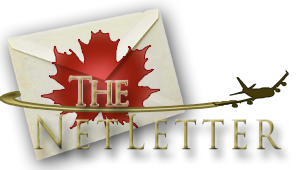|
Canadi>n/CPAir/PWA, Wardair, etc. Events & People
Over the past months we have been publishing various photographs from earlier in-house magazines, should any photos prompt a memory in seeing one of them, feel free to send us your comments and thoughts.
From the magazine "Change is in the air" magazine issued January 1999.




 The Canada goose, an internationally recognized symbol of Canada with a long history at Canadian, is coming back home after a 30 year hiatus. Canadian's family history, dating back to 1925, pays homage to this symbol and the entrepreneurial spirit it represents. The Canada goose, an internationally recognized symbol of Canada with a long history at Canadian, is coming back home after a 30 year hiatus. Canadian's family history, dating back to 1925, pays homage to this symbol and the entrepreneurial spirit it represents.
The unique talents and drive that our bush pilot ancestors carried with them into dozens of fledgling airlines have combined to create the Canadian Airlines of today. Those ancestors chose the Canada goose as their symbol because of what it represented. Western Canada Airways was the first to choose the Canada goose more than 70 years ago. The company wanted a bird native to Canada to symbolize endurance and nationality. A symbol that would help a growing number of international customers relate to the Canadian identity. Leonard Watson, the father of PWA President Don Watson, designed the logo. Western Canada Airways joined with four other airlines to become Canadian Airways in 1930, and the Canada goose was retained as the company logo.
Company aircraft were painted with a dark blue fuselage and orange wingtips and adorned with a flying goose insignia on their tails.
Canadian Pacific Air Lines purchased Canadian Airways in 1942 and the goose appeared on the new livery in the early years. It was gradually replaced by the Canadian Pacific corporate shield. Many employees, however, didn't want to say goodbye to their beloved symbol and surreptitiously kept it alive on airline documents. Another Canadian symbol, the beaver, was used as the airline's logo, but only for a few years. In 1951, the Canada goose regained its honored position after a Hong Kong based maintenance crew flippantly asked for help in restoring a damaged 'rodent' on one of the aircraft. The translator interpreted the word as 'rat'. Horrified, President Grant McConachie banished the beaver and restored the goose as the company symbol.
For 42 years, the Canada goose had played an important role in the identity of the airline. In 1968, it was retired. A renamed CP Air developed a new logo - a triangle, part of a circle, a square and a bright orange color. The triangle symbolized forward motion, the circle indicated a global company and the square meant corporate stability.The livery changed again in 1986 when the color scheme changed. The logo retained the half circle but now came with five rectangles representing the five continents the airline served.
In 1987, PWA, Nordair, CP Air, Eastern Provincial and later Wardair, joined to form Canadian Airlines. The Company retained a slightly altered CP Air logo which symbolized "wings across five continents". Over the years, the Canada goose played an important role with our partner airlines as well. PWA used a Canada goose as its emblem during its formative years before turning to the distinctive wings logo. And Eastern Provincial Airways, purchased by CP Air in 1984, used a Canada goose on its tail. In 1991, Canadian Regional Airlines was formed as a separate company to manage Time Air, Ontario Express, Inter-Canadien and Calm Air and CRA's new logos reflected the parent company.
Perusing the "Info Canadi>n" magazine
Issue dated October 1992
 Here we have this photo of the Canadian's sales team in Germany, Austria, Switzerland and Eastern Europe. Here we have this photo of the Canadian's sales team in Germany, Austria, Switzerland and Eastern Europe.
|
 Why not allow the NetLetter be your platform, and opportunity, to relive your history while working for either TCA, AC, CPAir, CAIL, PWA, AirBC etal. and share your experiences with us!
Why not allow the NetLetter be your platform, and opportunity, to relive your history while working for either TCA, AC, CPAir, CAIL, PWA, AirBC etal. and share your experiences with us! One of our readers recently passed through Londonderry Northern Ireland but, unfortunately, had no time to visit this interpretive centre.
One of our readers recently passed through Londonderry Northern Ireland but, unfortunately, had no time to visit this interpretive centre. 

















